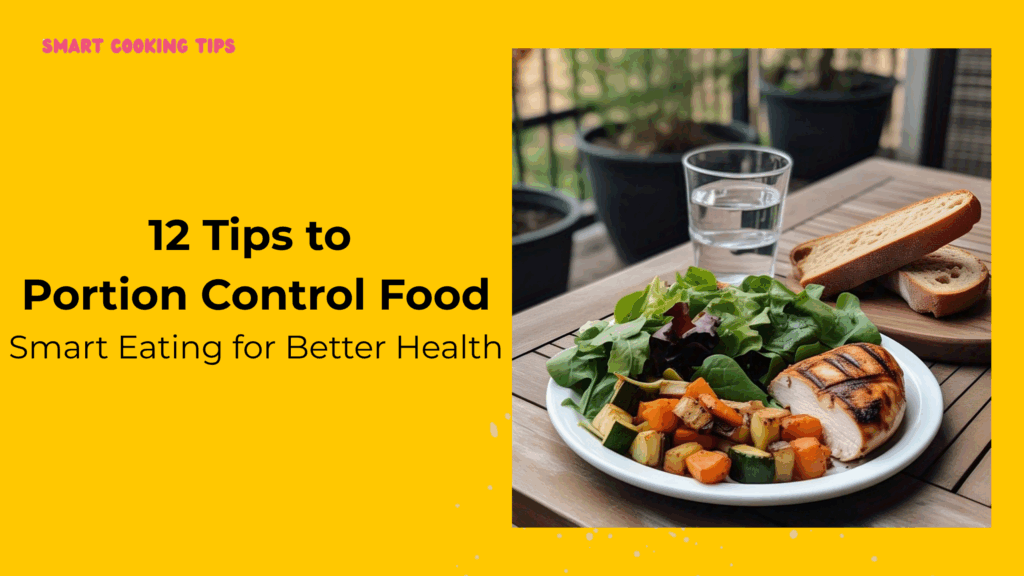In today’s health-conscious society, the focus is shifting from merely what we eat to how much we consume. Portion control practices are becoming increasingly vital as individuals seek effective ways to manage their weight, maintain energy, and enhance overall well-being. Portion control isn’t about strict dieting or deprivation; it’s about making mindful choices and understanding the balance between quantity and nutrition.
This blog delves into the science and practicality behind portion control food. You’ll discover how it supports better digestion, sustained energy levels, and even weight loss. Best of all, we’ll share real-life tips you can apply at home and when dining out.
What Is Portion Size and Why Does It Matter?
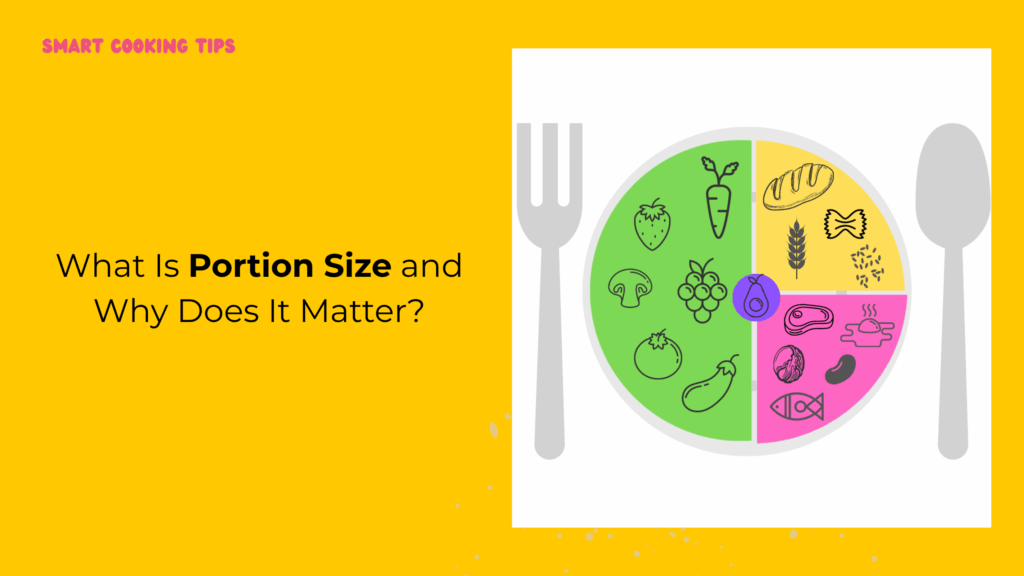
Portion size refers to the amount of food you serve yourself and consume in a single sitting, while serving size is a standardized unit used on nutrition labels (like 1 cup, 30 grams, or 1 slice). According to the American Heart Association, understanding this difference is crucial for building healthy eating habits.
For example, a serving of cooked pasta may be 1/2 cup, but many people serve themselves 2 cups or more—quadrupling their calorie intake without even realizing it. One of the biggest misconceptions is that you can eat unlimited quantities of “healthy” foods. While items like avocados, olive oil, and nuts offer nutritional benefits, they’re also calorie-dense and require mindful moderation.
Learning portion control food principles helps you stay in control of your health—without completely cutting out the foods you love.
What Are the Benefits of Portion Control?
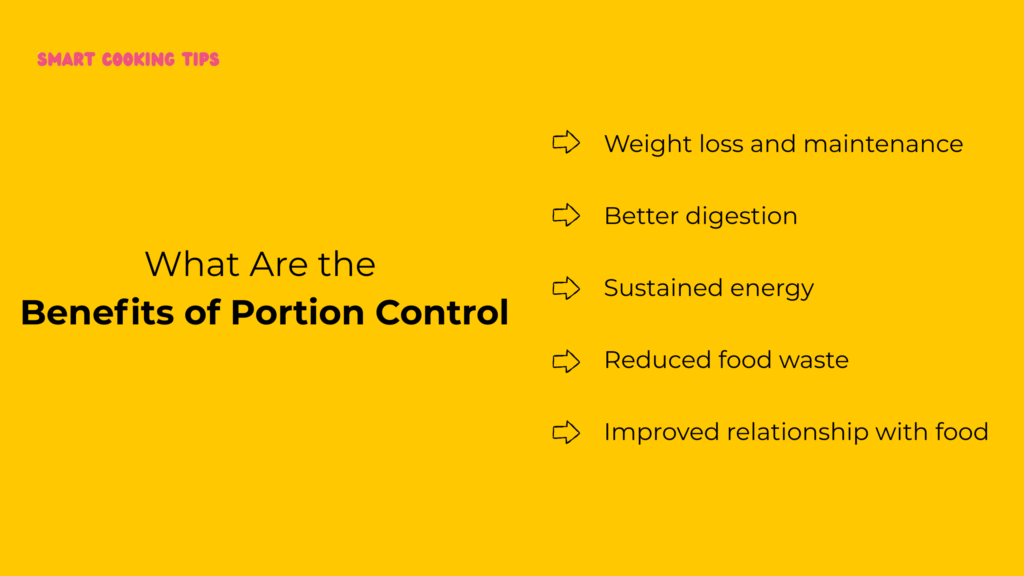
Portion control techniques are powerful because they address more than just calories. Here are some key benefits:
- Weight loss and maintenance: Eating the right amount reduces the risk of overeating and supports a healthy body composition.
- Better digestion: Smaller meals are easier for your digestive system to process, reducing bloating and discomfort.
- Sustained energy: Balanced portions throughout the day prevent energy crashes and keep blood sugar levels stable.
- Reduced food waste: Serving appropriate amounts minimizes leftovers and unnecessary waste.
- Improved relationship with food: Mindful eating fosters awareness, satisfaction, and better choices
How Much Should You Really Eat Each Day?
Your ideal portion control food plan depends on age, gender, activity level, and your specific health goals. But general dietary guidelines provide a solid foundation:
- Grains/Carbohydrates: 6–8 servings per day (1 serving = 1/2 cup cooked grains or 1 slice bread)
- Proteins: 5–7 ounces per day
- Fruits and Vegetables: At least 5 servings per day
- Healthy Fats: 2–3 tablespoons daily (focus on sources like olive oil, nuts, and seeds)
Recommended Portion Sizes for Adults (Visual Guide)
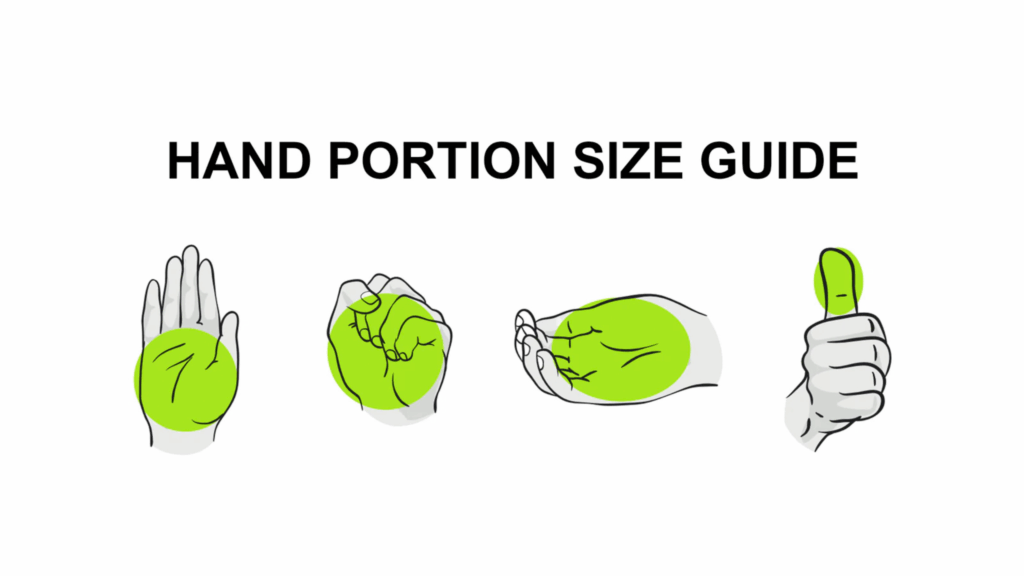
Using visual cues helps make portion control food easier and more intuitive:
- Proteins: About the size of your palm (3–4 oz)
- Carbohydrates: The size of your fist (1/2 to 1 cup)
- Vegetables: Half your plate
- Fats: About the size of your thumb
These simple comparisons empower you to estimate portions on the go—no measuring cups required.
12 Practical Tips to Master Portion Control Food Habits
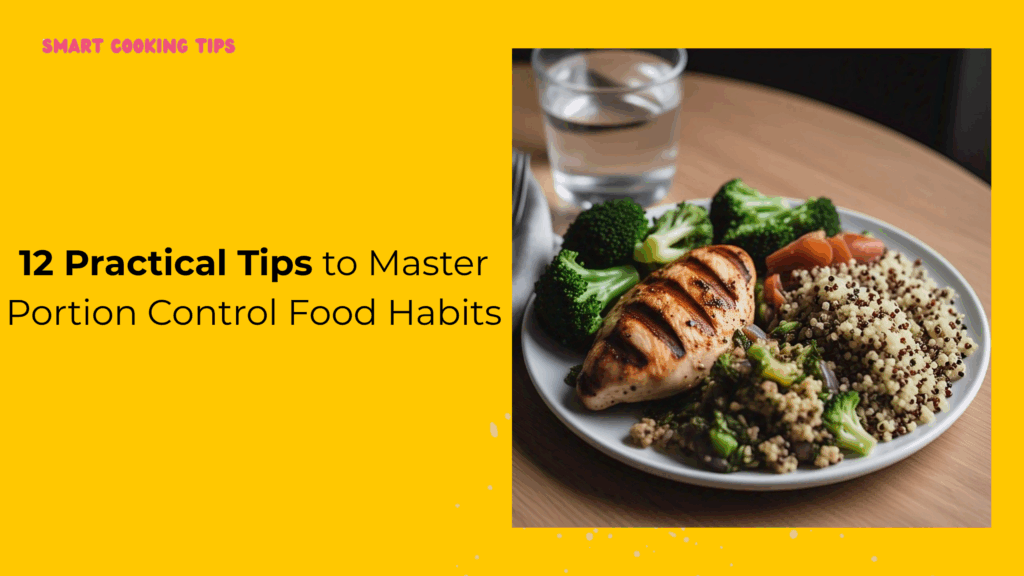
Use Visual Cues: Hands and Plates
- Divide your plate: ½ vegetables, ¼ protein, ¼ complex carbs.
- Your palm = protein, fist = carbs, cupped hand = veggies, thumb = fats.
This plate method makes portion control food balanced and visually appealing.
Downsize Your Dinnerware
Smaller plates and bowls can trick your brain into feeling full with less food. Studies have shown this psychological strategy leads to consuming fewer calories without feeling deprived.
Start Meals with Water
Drink a glass of water 15–30 minutes before eating. It promotes hydration and helps curb overeating by making you feel fuller.
Eat Slowly and Without Distractions
Put down your fork between bites, chew thoroughly, and savor the flavors. Avoid screens and multitasking to enhance awareness and satisfaction—a cornerstone of portion control food habits.
Never Eat Straight from the Container
Always transfer snacks and packaged foods to a plate or bowl. Eating directly from the bag often leads to consuming multiple servings without noticing.
Keep a Food Diary or App
Logging your meals makes it easier to stay on track. Apps like MyFitnessPal, Cronometer, or Lose It! help with portion control food planning and tracking over time.
Eliminate Mealtime Distractions
Silence your phone, turn off the TV, and focus on your plate. Being present while you eat increases your awareness of fullness cues.
Read Food Labels Closely
Always check the serving size and calories per serving on food labels. Many processed foods contain multiple servings per package, making it easy to overeat if you’re not careful.
Pre-Portion Bulk Purchases
When you buy snacks in bulk, divide them into individual containers or baggies as soon as you get home. This supports smarter portion control food choices throughout the week.
Fill Half Your Plate with Vegetables
Veggies are high in fiber, vitamins, and water content—and low in calories. They add volume and color to your meals without derailing your health goals.
Avoid Grazing From the Fridge
Eating while standing at the counter or in front of an open fridge often leads to mindless overeating. Always plate your food—even for small snacks.
Prioritize Protein and Fiber
Include a source of lean protein (chicken, fish, legumes) and fiber-rich foods (whole grains, fruits, veggies) in every meal. They promote fullness and help you stick to your portion control food goals.
ChopChop USA Kitchen Tools
The right tools can make portion control food practices easier and more enjoyable. ChopChop USA offers kitchen essentials that help you prep, portion, and cook with confidence:
Double-Sided Titanium Cutting Board
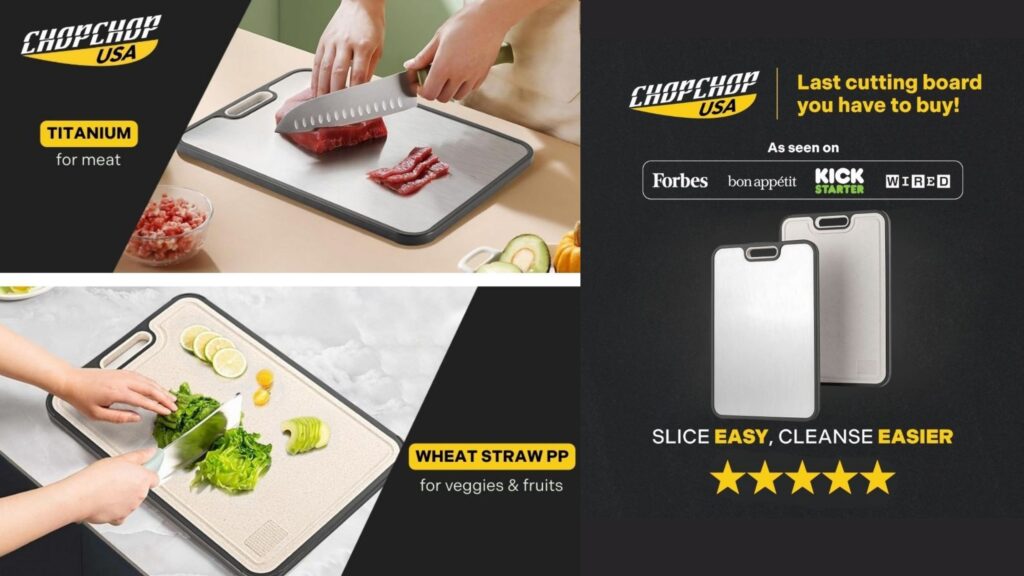
The Double-Sided Titanium Cutting Board from ChopChop USA is a must-have for anyone committed to portion control food practices. Its dual-surface design features one side made of 100% pure titanium—ultra-durable, non-reactive, and antibacterial—perfect for prepping meats, proteins, and other ingredients with precision. The titanium surface is knife-friendly, preserving the sharpness of your blades even with daily use.
On the flip side, the board includes a biodegradable wheat fiber surface with integrated juice grooves. This eco-conscious side is ideal for chopping vegetables and keeping your prep space clean and organized. Whether you’re portioning meals for the week or managing daily servings, this board offers convenience, hygiene, and sustainability all in one.
For a deeper dive into this versatile kitchen essential, be sure to read our full review: ChopChop USA Double-Sided Titanium Cutting Board Review
Boning Knife

The ChopChop USA Boning Knife is a high-performance tool built for precision and ease. Featuring a flexible ultra-thin blade and an ergonomic rosewood handle with a finger hole for added grip, it’s perfect for trimming fat, deboning meat, or portioning poultry with accuracy. The hand-finished 15-degree razor-sharp edge glides effortlessly through tough cuts, making portion control food prep efficient and stress-free. Its full tang construction and triple-riveted design offer lasting durability whether you’re working in the kitchen, grilling outdoors, or prepping meals for the week. This knife is an essential companion for anyone committed to smart, portioned eating.
To explore this boning knife in more detail, check out this blog: ChopChop Boning Knife Review – Is It Worth It?
Pure Titanium Utensil Set
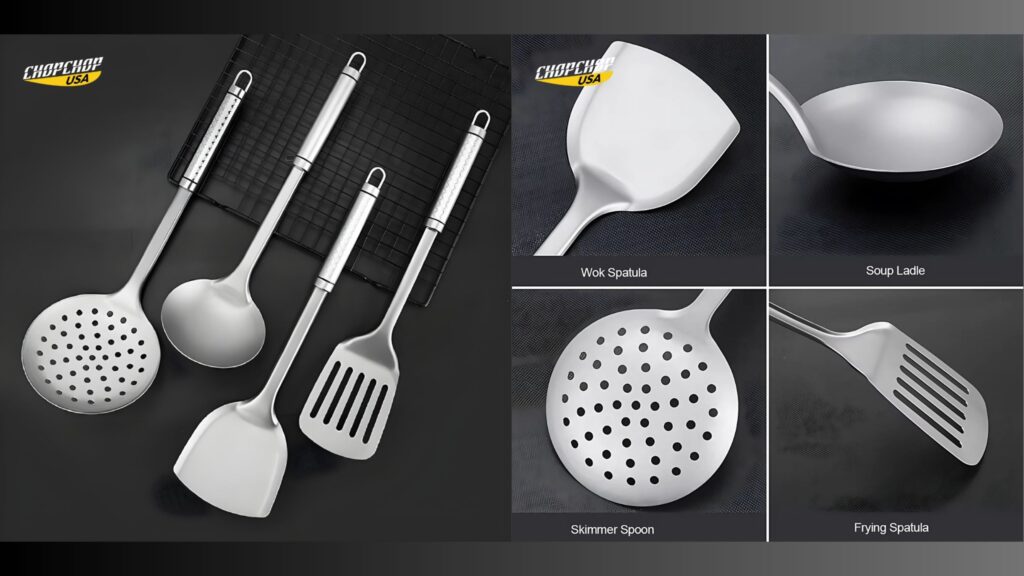
This premium Pure Titanium Utensil Set from ChopChop USA includes a Skimmer, Spatula, Turner, and Dipper—each crafted from 100% pure titanium for unbeatable strength and lightweight performance. Naturally antibacterial and non-toxic, these utensils are built to withstand high heat, resist corrosion, and ensure long-lasting durability. Their sleek, ergonomic design allows for precise cooking and effortless serving, making them ideal for maintaining portion control food practices at home or outdoors. Whether you’re stirring a hearty stew or plating sautéed veggies, these tools promote balance, cleanliness, and ease in the kitchen.
To explore this kitchen essential in more detail, check out this blog: ChopChop Kitchen Utensils Review – Is It Worth It?
Conclusion
Portion control food strategies go beyond dieting—they offer a sustainable, science-backed path to better health and energy. With mindful choices and small adjustments, you can enjoy your favorite meals, avoid overeating, and steadily move toward your wellness goals. It’s not about restriction; it’s about balance. Start with easy changes: use a smaller plate, eat more slowly, or drink a glass of water before meals. These simple habits build over time, creating lasting results. Embracing portion control doesn’t mean giving up the foods you love—it means enjoying them in a way that supports your body, lifestyle, and long-term health.
FAQs About Portion Control
What is the correct portion size for weight loss?
Use the hand guide and opt for smaller plates. Create a slight calorie deficit while eating whole foods and practicing portion control awareness.
Can portion control help without changing what I eat?
Absolutely. You don’t need to overhaul your entire diet—just reduce the quantity. Even without changing the type of food, smaller portions can lead to significant, sustainable results.
How do I teach my kids about portion control?
Use fun tools like divided plates, involve them in food prep, and model balanced eating. Teaching portion control habits early encourages a lifetime of healthier choices.
What tools help with portion control?
Try measuring cups, digital kitchen scales, pre-portioned containers, or portion-control plates. Visual guides like the plate method or hand estimation are helpful, too.


